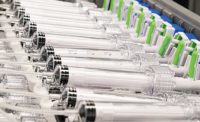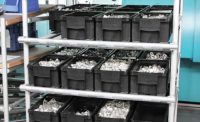At that moment, chances are good the hunter wasn't thinking about how his arrowhead was assembled. That's the job of engineers at New Archery Products (NAP, Forest Park, IL), a manufacturer of arrowheads and other bow hunting accessories.
One of the company's most innovative products is the Spitfire mechanical arrowhead. This reusable, broad arrowhead flies through the air in a compact, folded position for optimum flight characteristics, then opens up mechanically to deploy its blades upon impact. Because of its complexity, the arrowhead had to be carefully assembled by hand. Each head required the insertion of three scalpel-sharp, 0.03-inch thick hardened steel blades; three 0.004-inch thick, flat, stainless steel retention springs; and three stainless steel miniature screws. Each component had to be registered to one another within a 0.003-inch total tolerance zone.
Loading the blades presented a special challenge. Careful handling was required to ensure the safety of the assembler while preserving sharpness of the edges. Initially, NAP developed a manual fixture that shuttled each blade and spring clip into the slot and registered them to the tapped screw hole. The assembler still had the difficult task of picking up each screw, orienting it for insertion, and then finding the slot with the end of a jeweler's screwdriver.
The process worked, but production was slow. Assembler fatigue and the risk of repetitive motion injuries was unacceptably high. If NAP was going to keep up with consumer demand for the Spitfire, it was going to require a new assembly technology.
"We knew this would be a challenge because of the three miniature, slotted head 2-56 pivot screws used on each arrowhead," says Chris Kozlik, a design and manufacturing engineer at NAP. "We needed a battery of assembly personnel to perform the tedious task of inserting the razor-sharp blades and tightening the miniature screws with a jeweler's screwdriver."
Quality was also becoming an issue with the manual assembly method. "We were unable to tighten the screws to a consistent torque setting, resulting in some product that did not meet our stringent quality standards," says Kozlik. "The choices were clear: Automate or have the product produced overseas with cheap, plentiful labor."
Seeking a solution, NAP submitted sample parts to Deprag Inc. (Lewisville, TX), a manufacturer of power tools and assembly machines. After analysis, Deprag engineers suggested a Micromat single-spindle screwdriving system with automated screwfeeding. Available in three different speeds, the Micromat has a minimum torque capability of 3 in.-oz and a maximum torque capability of 97 in.-oz. Because of its low-torque capability, the screwdriver was ideally suited to assembling the arrowhead.
The screwdriving machine orients the screw, presents it to the workpiece, and consistently tightens it to the required torque of 11 in.-oz. A feedback signal informs the operator when the screwdriver clutch reaches its preset torque and shuts off. Sensors on the machine detect the presence of a screw on the spindle and measure the depth of the assembled screw.
NAP integrated the screwdriver into an assembly machine that also loads the arrow blades into the product's body. The result was a four-fold increase in throughput with improved product quality. "We've added three more Micromat systems since then," says Kozlik. "Operator fatigue has been greatly reduced, and we've consistently met ever-increasing product demand. The Micromats have proven to be very reliable, and both the screwdriver and the feeder unit have required little maintenance.
"The assembly personnel feel that, compared with the old method, the arrowheads almost assemble themselves, as if by magic. They call the machines 'Merlins' in honor of the fabled magician." For more information on automatic screwdriving machines, call Deprag at 800-433-7724, visit www.deprag.com

